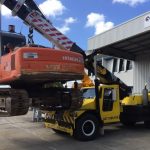
What are outriggers and what are they used for?
Mobile cranes are indispensable tools in various industries, facilitating the lifting and movement of heavy loads with precision and efficiency. Among the many components that contribute to their functionality and safety, outriggers stand out as essential features that ensure stability and reliability during lifting operations. Throughout our posts we have been diving into the different parts of mobile cranes today we’ll delve into the significance of outriggers on mobile cranes and how they enhance safety, versatility, and efficiency on job sites.
What are Outriggers?
Outriggers on a mobile crane are extendable supports attached to the crane’s chassis or base. They are designed to provide additional stability by widening the crane’s footprint when deployed. Outriggers can be extended horizontally, vertically, or both, depending on the crane’s design and the specific requirements of the lifting task.
Enhancing Stability:
One of the primary functions of outriggers is to enhance the stability of mobile cranes during lifting operations. By extending outward from the crane’s base, outriggers create a broader support area, effectively redistributing the weight of the crane and the load being lifted. This wider footprint helps counteract the forces exerted by the load, minimizing the risk of the crane tipping over or becoming unstable.
Load Distribution and Ground Pressure:
Outriggers also play a crucial role in distributing the crane’s weight over a larger area, thereby reducing ground pressure. This is particularly important when operating on soft or uneven terrain, where the risk of sinking or destabilization is higher. By spreading the load more evenly, outriggers help protect the ground surface and prevent damage to the underlying terrain.
Ensuring Safety:
Safety is paramount in crane operations, and outriggers contribute significantly to maintaining a safe working environment. By providing additional stability and load-bearing capacity, outriggers help minimize the risk of accidents such as tip-overs, collapses, or structural failures. Proper deployment and operation of outriggers are essential safety measures that crane operators must adhere to for safe and successful lifting operations.
Versatility and Adaptability:
Outriggers offer versatility and adaptability, allowing mobile cranes to be used in various settings and conditions. Whether working in tight spaces, on uneven ground, or at heights, outriggers enable cranes to maintain stability and maneuverability. This versatility enhances the crane’s utility across a wide range of construction, industrial, and infrastructure projects.
Outriggers are integral components of mobile cranes, playing a crucial role in ensuring stability, safety, and efficiency during lifting operations. By extending the crane’s footprint and distributing loads more effectively, outriggers enhance stability on a variety of terrains and in diverse working environments. Understanding the significance of outriggers and their proper deployment is essential for crane operators and construction professionals to ensure safe and successful project outcomes.





